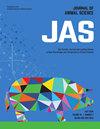Improving genetic gain in postpartum cows: A modified ovarian superstimulation protocol for ovum pick-up-in vitro embryo production during the voluntary waiting period
IF 2.7
2区 农林科学
Q1 AGRICULTURE, DAIRY & ANIMAL SCIENCE
引用次数: 0
Abstract
Ovarian superstimulation-ovum pick-up (OPU) technology facilitates the rapid propagation of animals with excellent genetic potential, substantially shortening the interval between generations. Research regarding OPU implementation during the voluntary waiting period (VWP), a phase with potential for maximizing genetic gains in high-yield herds, is limited. We aimed to optimize the dosage and frequency of follicle-stimulating hormone (FSH) injections in postpartum cows to develop an ovarian superstimulation protocol during the VWP for OPU-IVF and assess its effect on milk production and reproductive performance. Cows with more than three parities and within the top 10% of 305-day milk yield were selected as OPU donors. Donor cows were eligible for ovarian superstimulation starting at 40 days in milk (DIM) if they had completed uterine involution and showed no signs of intrauterine infection. Two superstimulation protocols were compared: three injections of 167 IU FSH (FSH-3 group) and five injections of 100 IU FSH (FSH-5 group). Donor cows underwent OPU between DIM 40–75, followed by a 10–15-day waiting period before artificial insemination (AI). A total of 95 cows (113 OPU sessions) were assigned to the FSH-5 group and 116 cows (135 OPU sessions) to the FSH-3 group. Milk yield data during this period and subsequent reproduction records of these donor cows were compared with those of non-donor cows. The results showed that the FSH-3 group achieved better results, including more 2–6-mm follicles and 6–10-mm follicles, a greater total follicle count, and greater recovery of cumulus-oocyte complexes (p<0.05). Additionally, the FSH-3 group produced more greater-grade oocytes, resulting in better production of blastocysts (p<0.05). Although the application of superstimulation-OPU to donor cows during the VWP delayed the DIM of the first AI (p<0.05), it significantly increased the pregnancy rate (p<0.05) and did not affect the subsequent reproductive performance of the parity. Milk yield temporarily declined on the day of OPU, but it gradually recovered. In summary, the FSH-3 protocol generated an average of more than four embryos per cow during the VWP without compromising reproductive performance, including service and pregnancy rates. These results suggest that the FSH-3 protocol is an effective strategy for obtaining embryos from high-yield cows during the VWP, enhancing genetic gain and accelerating breeding programs with minimal effect on future fertility.求助全文
约1分钟内获得全文
求助全文
来源期刊

Journal of animal science
农林科学-奶制品与动物科学
CiteScore
4.80
自引率
12.10%
发文量
1589
审稿时长
3 months
期刊介绍:
The Journal of Animal Science (JAS) is the premier journal for animal science and serves as the leading source of new knowledge and perspective in this area. JAS publishes more than 500 fully reviewed research articles, invited reviews, technical notes, and letters to the editor each year.
Articles published in JAS encompass a broad range of research topics in animal production and fundamental aspects of genetics, nutrition, physiology, and preparation and utilization of animal products. Articles typically report research with beef cattle, companion animals, goats, horses, pigs, and sheep; however, studies involving other farm animals, aquatic and wildlife species, and laboratory animal species that address fundamental questions related to livestock and companion animal biology will be considered for publication.
 求助内容:
求助内容: 应助结果提醒方式:
应助结果提醒方式:


